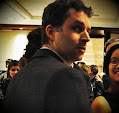Now, most people nowadays have digital cameras and internet access. Some gadget freaks actually have both, plus a global positioning system (GPS), all in a neat package, which makes it ultra-easy for them to go out in the woods and snap pictures of plants and animals around them. Special days called BioBlitzes have emerged recently where many people go out all at the same time but in different locations, to do just that. Then they report what they found on their respective blogs.
So where and how does it feed into science? Well, Sach's project provides Spotter, a Firefox extension, and a spreadsheet-to-RDF utility called RDF123, that together enable participants to easily do all of the following:
- Snap a picture of a specimen;
- Upload it to Flickr;
- Provide geographic information on where the photo was taken;
- Tag it with descriptive terms, as specifically as they can;
- If needed, request further crowdsourced identification (volunteers can watch RSS streams corresponding to certain tags like "bird" or "butterfly").
The overall result is obviously a global, collaborative database of samples from everywhere that gets richer with each participant's contribution. For participants, obvious motivations include:
- an interest in natural observation (think about birdwatchers);
- the satisfaction of contributing to a worthwhile scientific endeavor;
- the pride of offering something quite unique (info sampled at your particular location).
So far there are about 1200 observations in the system, but hopefully this number will grow as more people join the effort. I don't know too much about the viral properties of participation, but for starters, the fact that photos are posted into each people's Flickr stream exposes the project to their friends.
All in all, I think this is a very promising effort that exemplifies how amateurs and pros can complement each other given the right tools. There are obvious parallels to draw between this effort and other citizen science endeavors such as GalaxyZoo, which harnesses people's ability to classify galaxies better than computers, or the OpenStreetMap project, which aims to create free datasets of where streets are everywhere in the world.

No comments:
Post a Comment